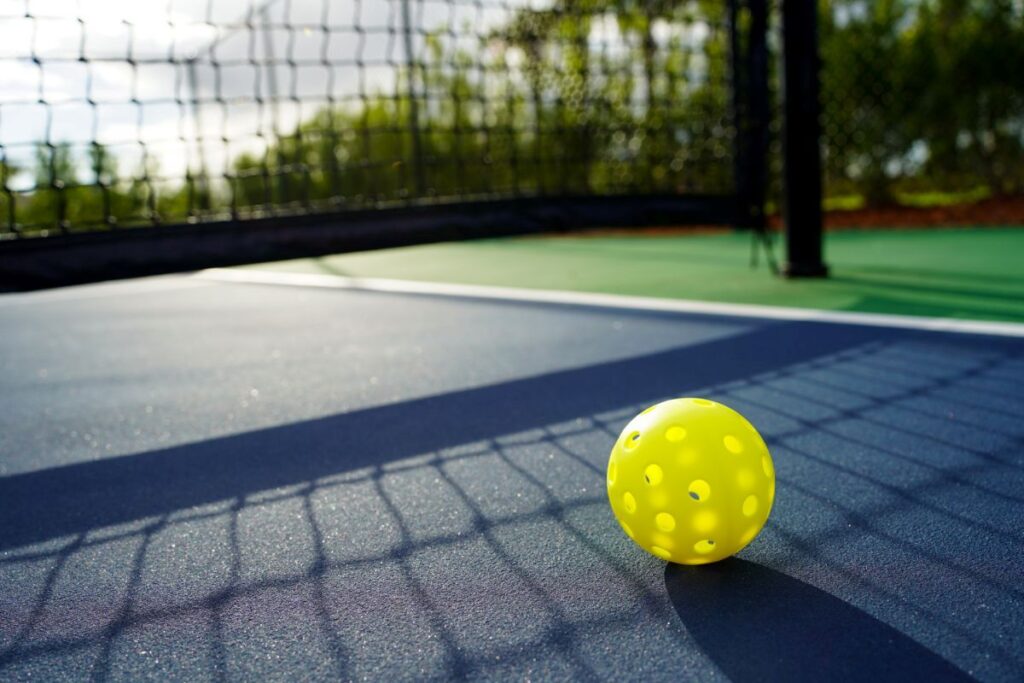While both spherical balls used in racket sports, tennis balls and pickleballs differ substantially in terms of size, weight, materials, bounce, speed, spin potential, cost considerations, and overall specs.
Here are 11 ways tennis balls and pickleballs diverge:
- Size – Tennis balls 6.5-6.7cm diameter, pickleballs 6.6-6.8cm.
- Weight – Tennis balls 57-59g, pickleballs 24-25g.
- Bounce – Tennis balls bounce higher with more deformation.
- Materials – Tennis uses felt/rubber, pickleballs plastic/polymer.
- History – Tennis balls from 1500s, pickleballs 1960s invention.
- Speed – Tennis serves hit 160+mph, pickleballs under 60mph.
- Spin – Tennis balls take more spin from racket friction.
- Records – Fastest tennis serve 163.4mph, no speed records in pickleball.
- Brands – Wilson, Penn lead tennis balls; Dura, Gamma, Onix dominate pickleballs.
- Durability – Tennis balls lose pressure quickly, pickleballs very durable.
- Cost – Pack of 3 tennis balls is $5, pickleballs $10-$30+ per dozen.
Below we’ll detail the specialized qualities that make tennis and pickleballs ideal for their respective sports’ unique demands. Game on!

Size Difference
Tennis balls are 6.5-6.7 cm in diameter on average. Regulation pickleballs measure 6.6-6.8 cm across.
So tennis balls are fractionally smaller. But both share a similar compact sphere profile optimal for racket face contact.
When I’d switch between them, the pickleball felt barely noticeably larger balanced on the racket strings.
Weight Difference
Tennis balls weigh 57-59 grams, giving them a light fluffy feel. Pickleballs have a featherlight weight of just 24-25 grams.
That substantial weight contrast contributes to the different pace potential. Tennis balls carry more mass, pickleballs maximize maneuverability.
Materials Used
Tennis balls have a rubber core surrounded by a nappy felt coating that provides grip and bounce.
Pickleballs feature a rigid polymer or plastic shell over a perforated core. The hard surface reduces spin.
So tennis balls focus on bounce, while pickleballs emphasize durability and weather resistance.
Bounce Characteristics
The felt coat and rubber core give tennis balls a lively high bounce with good deformation to absorb and return energy.
Pickleballs have a lower, flatter bounce off the paddle thanks to the rigid smooth plastic shell that doesn’t compress as much.
So tennis balls spring faster off the court, pickleballs have a controlled reaction.
Here’s a video that shows the kind of bounce you can expect from a pickleball:
History of Both Balls
Tennis balls originated from wood and leather before evolving to vulcanized rubber cores with a fuzzy felt coating over centuries of innovation.
Pickleballs were invented much more recently in the 1960s as a backyard recreational activity, taking inspiration from tennis but using a Wiffle ball.
Each ball aligns with innovations in its sport – tennis advancing for centuries, pickleball a modern invention.
Speed Difference
Well-struck tennis serves can blast up to 160+ mph thanks to the flexible racket face and fuzzy fast-launching ball.
Pickleballs top out around 60 mph in elite play. The light plastic ball limits maximum pace.
So tennis balls achieve radically faster speeds off the racket for more powerful shots.
Spin Potential
The soft fuzzy felt of tennis balls allows lots of grip on the strings for heavy topspin and slice shots.
The hard smooth plastic of a pickleball greatly reduces friction on the paddle face, restricting spin generation.
So tennis permits greater shot variety, pickleball focuses on placement more than spin.
World Records
- Fastest tennis serve: 163.4 mph by John Isner
- No official speed records kept in pickleball.
The 100+ mph pace differences highlight contrasting game speeds.
Brands and Manufacturers
Wilson, Penn, Dunlop dominate tennis ball production.
For pickleballs, Dura, Onix, Gamma, Franklin lead manufacturing.
Both sports benefit from innovations by major ball brands.
Storage and Maintenance
Tennis balls lose compression quickly. Storing in pressurized containers extends lifespan.
Thanks to durable polymer shells, pickleballs maintain bounce integrity for years with simple ambient storage.
So pickleballs are much lower maintenance over time.
Cost Considerations
Packs of 3 new tennis balls can cost as low as $2 per ball, as they are frequently replaced.
Premium pickleballs cost $10-$30+ per dozen but longer-lasting so replaced less often.
While pricier upfront, a pickleball can outlast dozens of tennis balls.
In summary, specialized designs make tennis and pickleballs excel at meeting the needs of their respective sports – one for pace and spin, the other optimized for control. Understanding their nuanced differences provides deeper appreciation of the impressive engineering inside each sphere!
